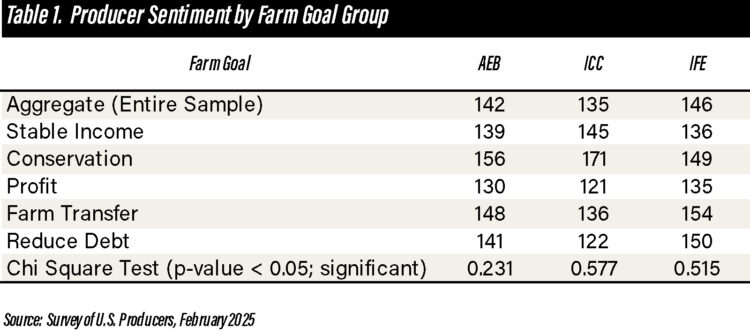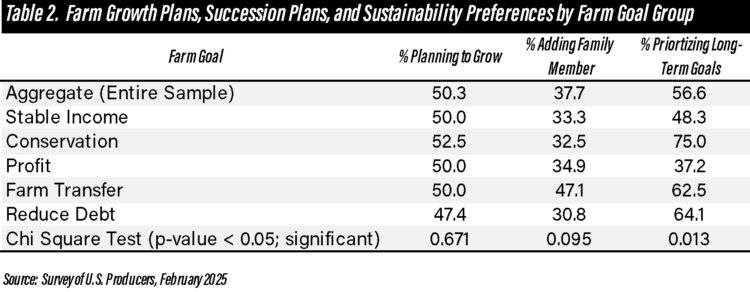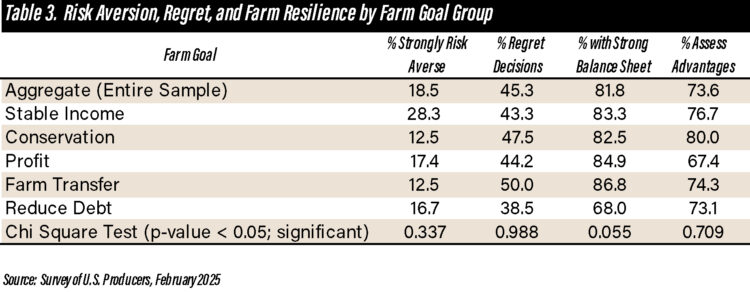July 23, 2025
Farm Goals
by Michael Langemeier & Anil Balchhaudi
A farm goal represents a predetermined target that an individual or a business wants to achieve in the short or long run. Goals help shape the destination of any business, but they are especially vital in production agriculture, where producers face uncertainties such as weather variability, market volatility, and far-ranging policy shifts. The added complexity of family involvement, multi-generational planning, and long-term investment horizons further underscore the need for clearly defined goals to guide strategic and operational decisions.
Family businesses typically set both personal and business goals. Personal goals are often related to financial security, family goals such as statements related to education and leisure time, and values or core beliefs. Business goals vary widely among farms. For example, previous surveys have identified the following common farm goals: survival, maximize profit, maintain or improve standard of living, accumulate assets and net worth, reduce debt, avoid or mitigate low-income years, pass the farm onto the next generation, increase leisure or free time, and improve soil health. These goals are not mutually exclusive and most farmers pursue a combination of them, often with varying emphasis depending on their farm size or type, financial condition, or market outlook. This article presents results from a recent survey pertaining to farm goals, and discusses the relationships between farm goals, producer sentiment, and farm characteristics.
Relative Importance of Various Farm Goals
Using a similar methodology as used to create the monthly Ag Economy Barometer, a survey of 400 U.S. producers was conducted in late February 2025 to assess individual farm goals, producer sentiment, farm growth, succession plans, sustainability and risk preferences, resilience, and adoption of conservation practices. This article focuses on farm goals.
Six survey questions addressed individual farm goals. The first 5 questions had respondents rank on a Likert scale from 1 to 5, with 1 indicating that a goal is not important and 5 indicating a goal that is very important, the relative importance of the following goals: avoid years of low profit, maintain stable income; maintain or improve the quality of soil, water, and air resources; maximize profits or get the best return on investment; pass the farm on to the next generation; and reduce debt over time. The sixth goal question asked respondents to identify their most important farm goal, based on the list of five goals noted above.
Adding up the scores for the first 5 goal questions resulted in an average goal score of 21.8. Obviously, a large proportion of the farms ranked numerous goals as either important or very important. In fact, 23.5% of the respondents indicated that all five goals were “very important”. The results of the identification of the most important farm goal are illustrated in figure 1. Farm transfer was chosen by 34.0% of the respondents as being the most important goal. Profit maximization and reduction in debt were chosen by another 21.5% and 19.5%, respectively. Goals were also highly correlated with one another. The only pair of goals that were not significantly correlated were the profit maximization and transition planning goals. The results clearly indicate that there is not one goal that dominates the rest of the goals. In other words, goals are multi-dimensional rather than uni-dimensional. We will discuss the implications of this result below.
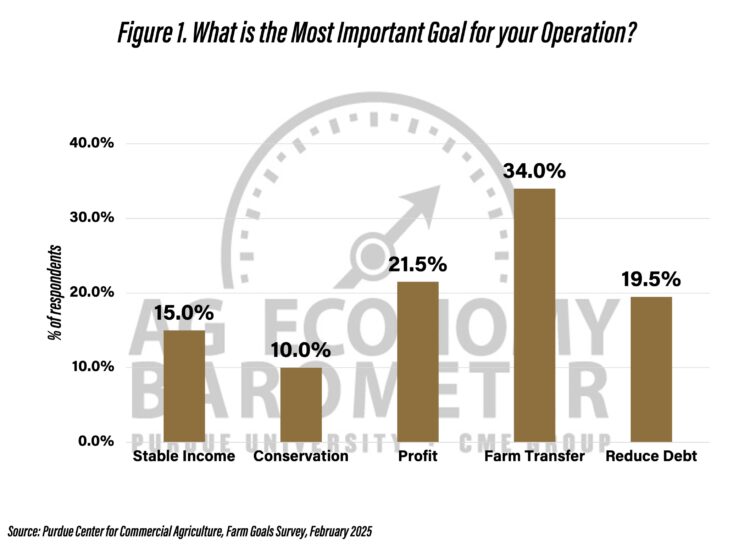
Figure 1. What is the Most Important Goal for Your Operation?, Purdue/CME Group Ag Economy Barometer Producer Survey February 2025
Relationship between Farm Goals and Farm Characteristics
We will next turn to the relationships between individual farm goals and various farm characteristics of respondents. Discussion will focus on items that were significantly different across goal choices.
Table 1 displays the index of current conditions (ICC), index of future expectations (IFE), and the ag economy barometer (AEB) for each of the five farm goals. The average ICC and AEB indices for those that chose profit maximization (conservation) as their most important goal were lower (higher) than the indices for the other farm goals. Respondents that chose farm transfer as their most important goal had the highest IFE index whereas those that chose profit as their most important goal had the lowest IFE. However, it is important to note that when examined as a group, there was not a significant difference in producer sentiment among the farm goal choices.
The differences in farm growth, succession plans, and sustainability preferences are depicted in table 2. The percentage of respondents who expect to expand their operations in the next five years was approximately 50% for each of the farm goal groups. As expected, the percentage of respondents that expected to bring a family member into the business at 47% was highest for those that chose transferring the farm business as their most important goal. Sustainability preferences (i.e., prioritization of long-run goals) were significantly different between the five farm goal groups. The percentage of respondents prioritizing long-term sustainability goals was substantially lower for the group that choice profit maximization as their most important goal compared to the group that choice conservation as there most important goal. Given the long-run nature of conservation decisions this is not particularly surprising.
Table 3 shows the differences in risk preferences, regret, and farm resilience among the five farm goal groups. Regret (i.e., once I make a decision, I don’t look back) and agility, measured as the assessment of advantages and disadvantages, are similar among the farm goal groups. Though not significantly different among the farm goal groups, as expected, a relatively higher percentage of respondents that chose stable income as their most important goal were strongly risk averse. In terms of absorption capacity, we asked respondents whether their farm had a strong balance sheet. On average, approximately 82% of respondents indicated that they have a strong balance sheet. In an April 2023 survey, 90% of respondents indicated that they had a strong balance sheet (Lippsmeyer et al., 2023). In this study, those that chose reduction in debt as their most important goal tended to have balance sheets that were not as strong as those that chose other farm goals.
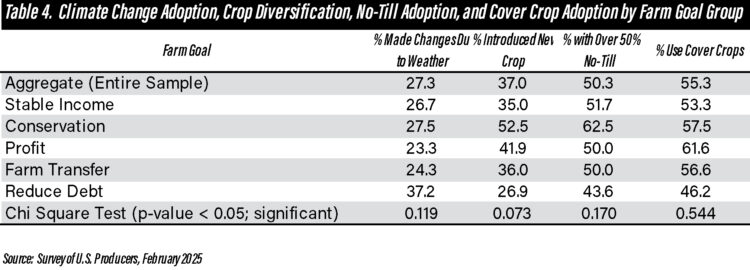
Table 4. Climate Change Adoption, Crop Diversification, No-Till Adoption, and Cover Crop Adoption by Farm Goal Group
The differences in climate adaptation, crop diversification, no-till adoption, and cover crop use are displayed in table 4. Adaptation to changing weather patterns and cover crop adoption are similar among the farm goal groups. In terms of climate adaptation, respondents were given the following choices: installed tile drainage, installed irrigation, planted cover crops, changed crop mix, adopted no-till, changed crop varieties, and changed planting dates. The three most common adaptations, in order, were changed planting dates, installed tile drainage, and changed crop varieties. Crop diversification (i.e., adding a new crop to improve long-run sustainability) and the adoption of no-till practices were relatively lower for respondents that choice reduction in debt as there most important goal and relatively higher for respondents that choice conservation as there most important goal. It is interesting to note that the respondents that chose reduction in debt as their most important goal tended to have lower rates of adoption in table 4. Their current financial position may make it more difficult to introduce a new crop, adopt no-till practices, and use cover crops.
The relationships between farm goals and farm demographics such as farm size, educational level, and operator age were also explored. There was a positive relationship between educational level and choosing conservation as a farm’s most important goal. Operator age was positively related to choosing the farm transfer goal and negatively related to choosing the reduction in debt goal. In other words, younger operations were more worried about repaying debt and older operators were more concerned about transferring the farm to the next generation.
Implications of Having Multiple Goals
As confirmed in our survey, it is very rare for a farm to have a single goal though some goals are more important than others. Having a hierarchy of goals is important because goals may conflict with one another. Rather than focusing on a single goal, such as profit maximization, it is often useful to think about tradeoffs between goals. For instance, an individual farm may have goals related to increasing net worth, risk mitigation, and soil health. It will be next to impossible to optimize these three goals simultaneously. Rather than optimizing each goal, think about a level for each of these goals that would be satisfactory or that the farm could live with. As another example, to reduce risk when making crop marketing decisions, it is usually necessary to reduce expected net returns. The optimal strategy involves trying to come up with a mix of marketing strategies that reduces risk more than it reduces expected net returns (Lenfestey and Langemeier, 2023).
Conclusions
This article presents results from a recent survey pertaining to farm goals, and discusses the relationships between farm goals, producer sentiment, and farm characteristics. Survey respondents were asked to identify their most important farm goal using the following list: stable income, conservation, profit, farm transfer, and reduce debt. All five goals were chosen by at least 10% of the respondents. The most common choice was farm transfer, which was chosen by one-third of the respondents. We encourage readers to think about the goals that are important to their farm or business. After listing important goals, think about the tradeoffs between these goals and how the goals can be used to make long-run strategic decisions.
Citations
Lenfestey, G. and M. Langemeier. “Comparing Corn Marketing Strategies.” Center for Commercial Agriculture, Department of Agricultural Economics, Purdue University, July 20, 2023.
Lippsmeyer, M., M. Langemeier, J. Mintert, and N. Thompson. “Factors Impacting Succession Planning.” Center for Commercial Agriculture, Department of Agricultural Economics, Purdue University, September 7, 2023.
TAGS:
TEAM LINKS:
RELATED RESOURCES
UPCOMING EVENTS
December 1 & 8, 2025
Join Purdue Extension for a two-part workshop designed to help you gain a clearer understanding of tax planning essentials. The first session on December 1 will focus on the fundamentals of farm taxes, with particular emphasis on strategies that can be used in a low net income year. The second session on December 8 will focus on key tax strategies and will allow plenty of time for questions. Registration cost is only $20.
Read MoreDecember 15, 2025
This program provides in-depth coverage of agricultural and farm tax issues. In addition to covering timely tax issues, we will cover disaster tax issues, depreciation and expensing farm assets, retirement planning for farms, and tax planning in low-income years. This year’s webinar will be co-taught by a team from Ohio State and Purdue Universities.
Read MoreJanuary 27 or 28, 2026
Farm Shield is more than a conference, it’s a commitment to helping agricultural families build resilience and plan for a secure future. Don’t miss this opportunity to protect your legacy!
Read More